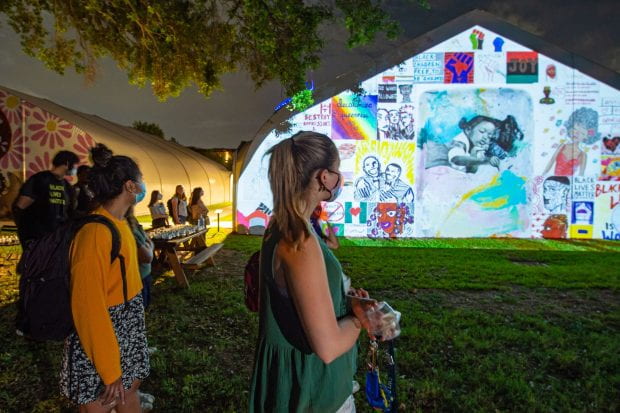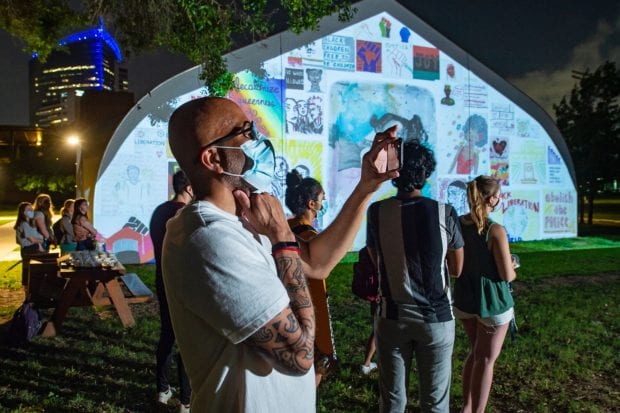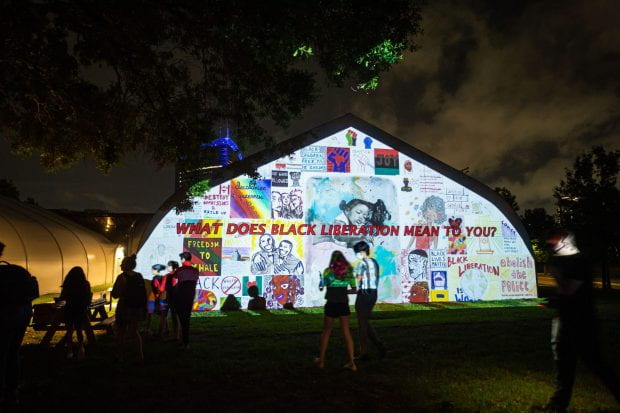Community-sourced art piece by Religion and Black Lives Matter students was projected nightly for a week
What does Black liberation mean to you?
This is the question posed by students in Religion and Black Lives Matter for their final project: a mosaic of artwork collected from Rice community members, anchored by a lush, large-scale piece from Lanecia Rouse, the current artist-in-residence at Rice’s Center for Engaged Research and Collaborative Learning.
Rouse creates dramatic mixed-media pieces using acrylics, charcoal, pastels, watercolors and, sometimes, old issues of Ebony magazine. Her collage for the Religion and Black Lives Matter mosaic shows a young Black girl, trimmed from the pages of Ebony, lying down and painting peacefully. Another piece of art above it calls for “Black children free to be children,” while other pieces depict two Black men laughing in a sidelong embrace, the word “JOY” emblazoned on the Pan-African flag and the Rice academic quad empty of William Marsh Rice’s statue.
The mosaic debuted just after sunset on April 26, projected onto the side of Provisional Campus Facility #1 — the large white tent closest to Kraft Hall on the lawn outside Wiess College, next door to the tent that’s the site of Houston artist Jasmine Zelaya’s flower-flocked painting “Detroit Red,” a tribute to Malcolm X.
Organized entirely by the class of 18 students, the mosaic projection’s debut marked the end of weeks’ worth of work brainstorming a final project, contacting students and artists like Rouse about participating, hosting an art-making event at Ray’s Courtyard and providing materials for students to use, soliciting other pieces virtually through online submissions, creating a mosaic from the pieces and securing a site that would allow them to project the work for an entire week.
They even brought 180 cupcakes for guests, who flocked from across campus to catch the first nightly screening.
“I’m so proud of the students who put together this event under some rather difficult circumstances,” said Anthony Pinn, the Agnes Cullen Arnold Professor of Humanities and professor of religion, who co-taught the course this semester with doctoral student Mark DeYoung. “Three semesters into COVID-conditioned education, they showed such great creativity and imagination.”
In a previous final project for the course in 2018, students convened a panel at the Moody Center for the Arts on the topic of “Black Lives Matter: Reimagining the Black Future,” hosting local activists and a dance performance by Houston’s Urban Souls Dance Company. This year, students once again centered Black voices in the local community, a decision influenced by the “leaderful” nature of the Black Lives Matter movement.
As the students explained, the civil rights movement featured people like Martin Luther King Jr. leading up front, while the Black Lives Matter movement is a more grassroots organization without one individual leader. Rather, it’s full of leaders — leaderful, if you will.
“Dr. Pinn and Mark really tried to embrace that leaderful movement in class, with lots of discussions and breakout room sessions, so this group project came out of the students’ ideas as well as community efforts,” said Will Rice junior Lauren Ross, a viola performance and religion double major who took the course this semester.
Fellow classmate Adith Ram, a Baker College senior majoring in psychology, said this mindset was vital as they all worked toward their final project.
“One thing we definitely talked a lot about was how to center the Black students on campus and their perspectives more than our own,” Ram said.
The students were also mindful of creating an on-campus event with food and music that would encourage guests to enjoy an extended amount of time examining the mosaic.
During the debut, the students read quotes from two of their class readings this semester, which were also used as artists’ prompts for the mosaic. A line from Keeanga-Yamahtta Taylor’s “How We Get Free: Black Feminism and the Combahee River Collective” was one of them: “If Black women were free, it would mean that everyone else would have to be free since our freedom would necessitate the destruction of all the systems of oppression.”
Pinn said he was proud of the way the students’ mosaic also encouraged “visions of a different world that honor the affective dimensions of our collective experience” while speaking to the central topics of the Religion and Black Lives Matter course.
“One of the dimensions of the project I found most compelling is the way in which they offered opportunity to decenter words and to begin thinking about issues of social justice in more expansive ways,” Pinn said. “They recognized and honored art as an important way to challenge our safe and typical perception of the world.”
The second and final portion of the class project is still to come: an educational video series and compilation of resources. Four video interviews with Rice community members and local activist Brandi Holmes will feature questions based around expanding the public’s understanding of Black Lives Matter as the students seek to share what they learned this semester with others.
Although the digital mural projection only lasted a week on campus, it will live on virtually alongside those video interviews and other resources the students compiled in a website they say they’re launching soon.




